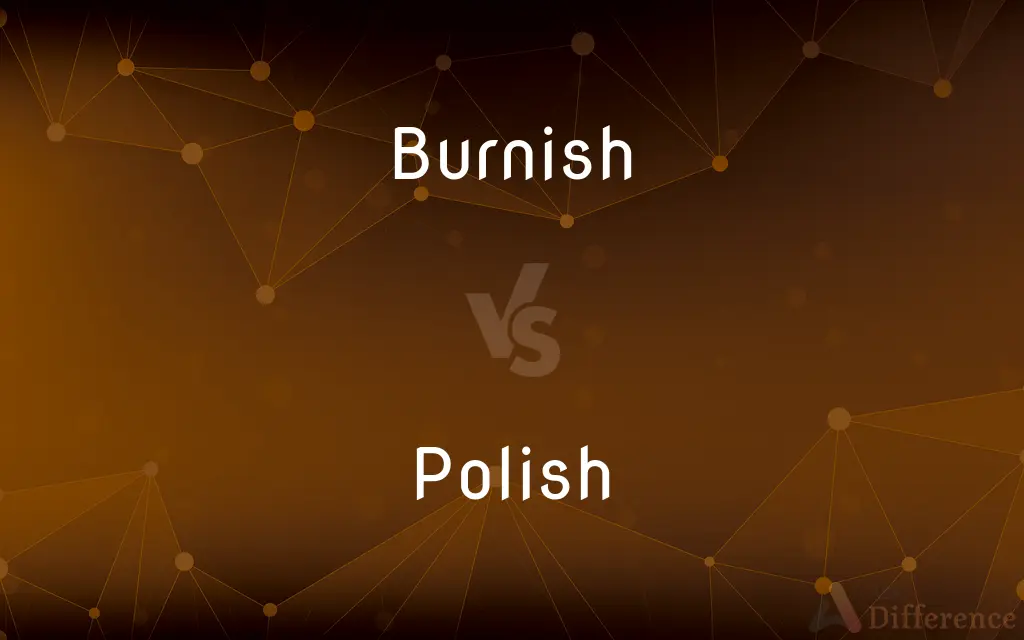Burnish vs. Polish — What's the Difference?
By Tayyaba Rehman & Maham Liaqat — Updated on April 2, 2024
Burnish involves enhancing a surface's shine through friction, while polish refers to making a surface smooth and shiny, often with chemical treatment.

Difference Between Burnish and Polish
Table of Contents
ADVERTISEMENT
Key Differences
Burnish is a process that specifically aims to enhance the shine or gloss of a surface through the application of friction. It is often used for metals and wood, where the goal is to produce a high shine without necessarily removing all surface imperfections. On the other hand, polish refers to the broader action of making a surface smooth and glossy, which can involve both mechanical action and the application of chemical agents. Polishing is used on a variety of materials, from metal and wood to nails and shoes, and it can serve both aesthetic and protective purposes.
While burnishing focuses on the physical process of creating a shine through rubbing or friction, often to a specific area, polishing encompasses a wider range of techniques, including the use of abrasives and chemicals to achieve a smooth, reflective surface. This means that while all burnishing can be considered a form of polishing, not all polishing is burnishing. The choice between burnishing and polishing depends on the desired outcome and the material being treated. Burnishing is preferred for its ability to enhance the texture and luster of a surface without removing material, making it ideal for fine artwork or delicate items.
Polishing, with its capacity to both smooth out imperfections and bring out a high shine, is more versatile and can be used for both initial surface preparation and finishing touches. It is the go-to method for restoring luster to tarnished or scratched items, or for preparing surfaces for further treatment. The distinction between burnish and polish is thus not just about the methods used, but also about the end results: burnishing for a specific, enhanced shine through friction, and polishing for overall smoothness and gloss, often involving a combination of mechanical and chemical processes.
Comparison Chart
Process
Enhancing shine through friction.
Making smooth and shiny through abrasion and/or chemicals.
Purpose
To produce a high shine without removing material.
To smooth and increase gloss, possibly removing imperfections.
ADVERTISEMENT
Materials
Commonly used on metals and wood.
Applicable to a wide range of materials.
Techniques
Primarily friction-based.
Includes mechanical action and chemical treatment.
End Result
Enhanced texture and luster.
Overall smoothness and shine.
Compare with Definitions
Burnish
To enhance shine through friction.
The jeweler burnished the gold bracelet to restore its original shine.
Polish
To make smooth and shiny, often using abrasives or chemicals.
She polished her nails to a perfect shine.
Burnish
Ideal for fine artwork or delicate items.
The artist burnished the clay pot, giving it a smooth, glossy surface.
Polish
Versatile, used on various materials.
The mechanic polished the chrome bumper until it reflected like a mirror.
Burnish
Used on metals and wood for a high shine.
The carpenter burnished the wooden sculpture until it gleamed.
Polish
Can remove imperfections during the process.
Polishing the wooden floor removed the scratches and made it look new.
Burnish
Often manual, using tools like steel wool or a burnisher.
He used a leather burnisher to finish the edges of the wallet.
Polish
May involve both mechanical action and chemical agents.
Using a polishing compound, he restored the shine to the tarnished silverware.
Burnish
Does not remove material, focuses on shine.
Burnishing the coin brought out its details without altering its shape.
Polish
For both aesthetic and protective purposes.
The museum curator polished the ancient bronze statue to preserve its appearance.
Burnish
Polish (something, especially metal) by rubbing
Highly burnished armour
Polish
Of or relating to Poland, the Poles, their language, or their culture.
Burnish
The shine on a highly polished surface.
Polish
The Slavic language of the Poles.
Burnish
To make smooth or glossy by rubbing; polish.
Polish
Smoothness or shininess of surface or finish.
Burnish
To rub with a tool that serves especially to smooth or polish.
Polish
A substance containing chemical agents or abrasive particles and applied to smooth or shine a surface
Shoe polish.
Burnish
To improve or make more impressive
Achievements that burnished her reputation.
Polish
The act or process of polishing
Gave the lamp a polish.
Burnish
A smooth glossy finish or appearance; luster.
Polish
Elegance of style or manners; refinement.
Burnish
(transitive)
Polish
To make smooth and shiny by rubbing or chemical action.
Burnish
To make (something, such as a surface) bright, shiny, and smooth by, or (by extension) as if by, rubbing; to polish, to shine.
In pottery, a stone is sometimes used to burnish a pot before firing, giving it a smooth, shiny look.
Polish
To remove the outer layers from (grains of rice) by rotation in drums.
Burnish
Of a stag: to remove the fur]] from (its antlers) by rubbing them against something; to velvet.
Polish
To refine or remove flaws from; perfect or complete
Polish one's piano technique.
Polish up the lyrics.
Burnish
(figuratively) To make (someone or something) appear positive and highly respected.
Polish
To become smooth or shiny by being rubbed
The table polishes up nicely.
Burnish
(intransitive)
Polish
A substance used to polish.
A good silver polish will remove tarnish easily.
Burnish
To become bright, glossy, and smooth; to brighten, to gleam, to shine forth.
Polish
Cleanliness; smoothness, shininess.
The floor was waxed to a high polish.
Burnish
(figuratively) To appear positive and highly respected.
Polish
Refinement; cleanliness in performance or presentation.
The lecturer showed a lot of polish at his last talk.
Burnish
Of a person's body: to grow large or stout; to fatten, to fill out.
Polish
(transitive) To shine; to make a surface very smooth or shiny by rubbing, cleaning, or grinding.
He polished up the chrome until it gleamed.
Burnish
(by extension) Of a thing: to increase in size; to expand, to spread out, to swell.
Polish
(transitive) To refine; remove imperfections from.
The band has polished its performance since the last concert.
Burnish
(countable)
Polish
(transitive) To apply shoe polish to shoes.
Burnish
A shine of something which has been polished; a lustre, a polish.
Polish
(intransitive) To become smooth, as from friction; to receive a gloss; to take a smooth and glossy surface.
Steel polishes well.
Burnish
A shiny layer applied to a surface or other thing.
Polish
(transitive) To refine; to wear off the rudeness, coarseness, or rusticity of; to make elegant and polite.
Burnish
(uncountable) The making of something bright, shiny, and smooth by, or (by extension) as if by, rubbing; (countable) an instance of this; a burnishing, a polishing, a shining.
With a good burnish, the old table should fetch a higher price.
Polish
Of or pertaining to Poland or its inhabitants.
Burnish
To cause to shine; to make smooth and bright; to polish; specifically, to polish by rubbing with something hard and smooth; as, to burnish brass or paper.
The frame of burnished steel, that east a glareFrom far, and seemed to thaw the freezing air.
Now the village windows blaze,Burnished by the setting sun.
Polish
To make smooth and glossy, usually by friction; to burnish; to overspread with luster; as, to polish glass, marble, metals, etc.
Burnish
To shine forth; to brighten; to become smooth and glossy, as from swelling or filling out; hence, to grow large.
A slender poet must have time to grow,And spread and burnish as his brothers do.
My thoughts began to burnish, sprout, and swell.
Polish
Hence, to refine; to wear off the rudeness, coarseness, or rusticity of; to make elegant and polite; as, to polish life or manners.
Burnish
The effect of burnishing; gloss; brightness; luster.
Polish
To become smooth, as from friction; to receive a gloss; to take a smooth and glossy surface; as, steel polishes well.
Burnish
The property of being smooth and shiny
Polish
A smooth, glossy surface, usually produced by friction; a gloss or luster.
Another prism of clearer glass and better polish.
Burnish
Polish and make shiny;
Buff the wooden floors
Buff my shoes
Polish
Anything used to produce a gloss.
Polish
Fig.: Refinement; elegance of manners.
This Roman polish and this smooth behavior.
Polish
The property of being smooth and shiny
Polish
A highly developed state of perfection; having a flawless or impeccable quality;
They performed with great polish
I admired the exquisite refinement of his prose
Almost an inspiration which gives to all work that finish which is almost art
Polish
A preparation used in polishing
Polish
The Slavic language of Poland
Polish
(of surfaces) make shine;
Shine the silver, please
Polish my shoes
Polish
Improve or perfect by pruning or polishing;
Refine one's style of writing
Polish
Bring to a highly developed, finished, or refined state;
Polish your social manners
Polish
Of or relating to Poland or its people or culture;
Polish sausage
Common Curiosities
What is the primary difference between burnishing and polishing?
The primary difference lies in the method and purpose: burnishing enhances shine through friction without removing material, while polishing smooths and makes a surface shiny, potentially removing imperfections.
Is polish used only for aesthetic reasons?
While often used for aesthetics, polish also serves protective purposes by creating a smoother surface that can be more resistant to dirt and degradation.
Why might someone choose burnishing over polishing?
Someone might choose burnishing over polishing if they want to enhance the shine of a surface without removing any material, particularly for delicate or fine items.
How does polishing affect a surface’s texture?
Polishing can significantly smooth a surface’s texture, reducing roughness and imperfections to create a glossy, reflective finish.
How do chemical polishes work?
Chemical polishes work by reacting with the surface material to smooth it, often filling in microscopic imperfections and creating a protective layer.
Is specialized equipment required for burnishing or polishing?
While some burnishing and polishing tasks can be done manually, specialized equipment can achieve a more uniform and efficient result, especially for polishing.
Can burnishing remove scratches or imperfections?
Burnishing primarily enhances shine and may not remove deep scratches or imperfections, as it does not involve removing material from the surface.
What materials can be burnished?
Materials commonly burnished include metals and wood, where a high shine without altering the surface is desired.
Can all surfaces be polished or burnished?
Not all surfaces are suitable for polishing or burnishing; the method chosen depends on the material's characteristics and the desired outcome.
How can one maintain the shine after burnishing or polishing?
Maintaining shine after burnishing or polishing involves regular cleaning and, for some materials, periodic reapplication of polish or another protective coating.
Share Your Discovery

Previous Comparison
Fog vs. Frog
Next Comparison
Hypertelorism vs. TelecanthusAuthor Spotlight
Written by
Tayyaba RehmanTayyaba Rehman is a distinguished writer, currently serving as a primary contributor to askdifference.com. As a researcher in semantics and etymology, Tayyaba's passion for the complexity of languages and their distinctions has found a perfect home on the platform. Tayyaba delves into the intricacies of language, distinguishing between commonly confused words and phrases, thereby providing clarity for readers worldwide.
Co-written by
Maham Liaqat















































